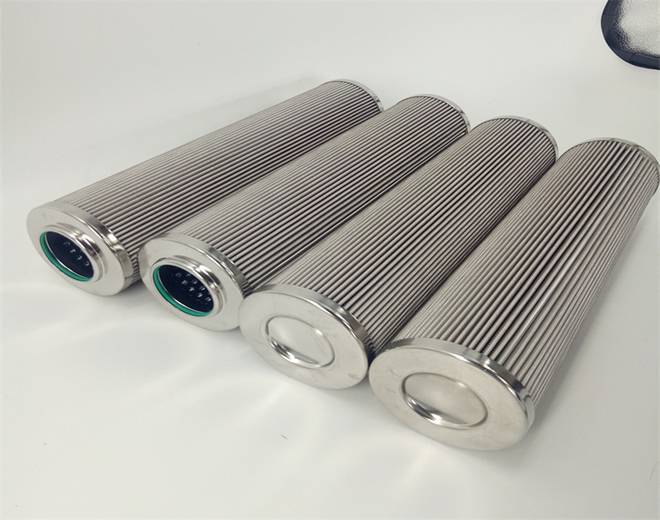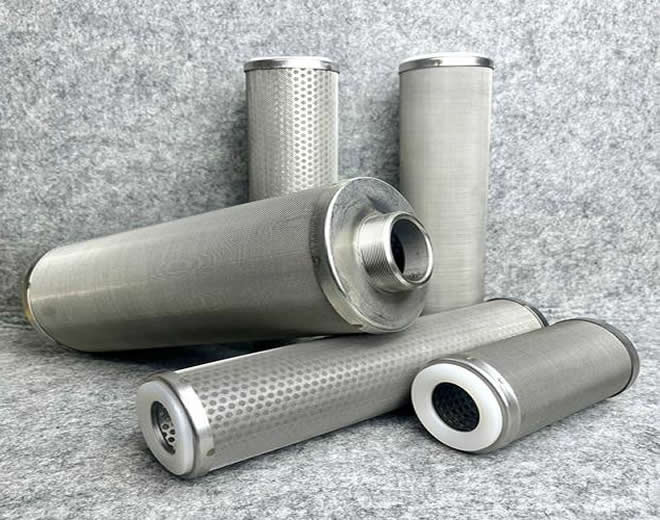









In demanding industrial filtration applications, single-performance filter media often struggle to cope with complex and variable conditions. The multi-layer sintered wire mesh filter cartridge, with its ingeniously designed composite structure, integrates strength, precision, dirt-holding capacity, and stability into a single unit, serving as the precision engine that protects critical equipment and processes.
A multi-layer sintered wire mesh filter cartridge is a rigid, monolithic porous filtering element made by layering at least three (typically three or five) sheets of stainless steel woven wire mesh with different pore sizes and wire diameters in a specific sequence (typically Protective Layer → Filter Layer → Support Layer). This stack is then fused together using high-temperature vacuum sintering, followed by pressing and rolling.
The core lies in "Sintering": This process creates a firm metallurgical bond at the contact points between the layers, rather than a simple mechanical layup. This results in a new filtering material with superior performance characteristics.
A standard five-layer structure perfectly illustrates its design philosophy:
Layer 1 (Outermost): Coarse Protective Layer
Function: To intercept large particles, protect the inner precision filter layer, and withstand the main fluid impact.
Characteristics: Largest pore size, thickest wire diameter, high mechanical strength.
Layers 2 & 4: Transition Layers
Function: Act as bridges, creating a smooth transition from coarse to fine and back to coarse. This establishes an ideal pore gradient, guiding particles to be trapped in an orderly manner within the media and optimizing dirt-holding space.
Layer 3 (Core Layer): Precision Filter Layer
Function: The key layer for achieving absolute rating filtration, responsible for retaining the target-sized fine particles.
Characteristics: Smallest pore size, finest wire diameter, determines the cartridge's nominal filtration rating.
Layer 5 (Innermost): Coarse Support Layer
Function: Provides strong mechanical support for the entire cartridge, especially for the fragile precision filter layer, preventing deformation or damage under pressure differential.
High Strength and Rigidity
The monolithic sintered structure and robust support layer enable it to withstand very high pressure differentials and frequent mechanical shock without deformation or damage.
Absolute Rating and High Reliability
The precision filter layer enables absolute surface filtration. The pore structure is uniform and stable, with no media migration, ensuring consistent and reliable filtration performance.
Deep Dirt-Holding Capacity and Long Service Life
The unique pore gradient design allows particles to be deeply trapped within the transition layers of the media, rather than just plugging the surface. This results in a dirt-holding capacity far exceeding that of single-layer wire mesh, extending service life.
Excellent Back-Pulse Cleaning and Regenerability
Thanks to its rigid structure and primary surface filtration mechanism, trapped contaminants can be efficiently removed via high-pressure back-pulsing or ultrasonic cleaning. It offers good performance recovery, is reusable, and provides a low total cost of ownership.
Outstanding Temperature Resistance and Chemical Stability
Made from materials like stainless steel (e.g., 304, 316L), it can withstand high temperatures, high pressure, and corrosion from a wide range of chemical media, making it suitable for an extremely broad range of applications.
Its exceptional combination of properties makes it the preferred choice in the following fields:
Polymer Industry: Filtration of high-temperature, high-viscosity melts (e.g., polyester, nylon), protecting precision spinnerets.
Hydraulic & Lubrication Systems: Used as high-pressure line filters to protect sensitive components like servo valves and pumps.
Chemical & Petrochemical Industry: Catalyst recovery, fine filtration of process fluids, and used as gas distributors.
Pharmaceutical & Biotech: Sterilizing filtration of Water for Injection (WFI), pure steam, and fermentation air, complying with GMP requirements.
Food & Beverage: Clarification filtration of wine, beer, edible oils, etc.
Nuclear Power & Aerospace: Filtration in critical locations where safety and reliability are paramount.
| Feature | Multi-Layer Sintered Mesh Cartridge | Single-Layer Wire Mesh Cartridge | Sintered Fiber Felt Cartridge | Pleated Paper Cartridge |
|---|---|---|---|---|
| Structure | Multi-layer composite, gradient pores | Single layer, uniform pores | 3D random fibers | Depth filter paper |
| Strength | Very High | Moderate | Good | Low |
| Filtration Mechanism | Surface + Gradient Depth Filtration | Absolute Surface Filtration | Depth Filtration | Depth Filtration |
| Dirt-Holding Capacity | High | Low | Very High | High |
| Reusable | Yes | Yes | Limited times | No |
| Rating Reliability | High | High | Moderate | Moderate |
Filtration Rating: Select based on the smallest particle size that needs to be removed.
Material: Choose based on fluid chemistry (corrosiveness) – e.g., 304, 316L, Hastelloy.
Pressure Differential Tolerance: Confirm the system's maximum working and shock pressure, and select a cartridge with sufficient strength.
Total Cost of Ownership: For heavily contaminated duties, the cleanable and reusable feature often makes it more cost-effective over its entire lifecycle.
The multi-layer sintered wire mesh filter cartridge represents a high level of design and manufacturing in metal filtration media. It is more than just a filter; it is a high-performance system achieved through precision engineering. Choosing it means selecting the optimal balance of strength, precision, longevity, and reliability for your core processes. It is a strategic investment in ensuring production continuity, enhancing product quality, and reducing the total cost of ownership.